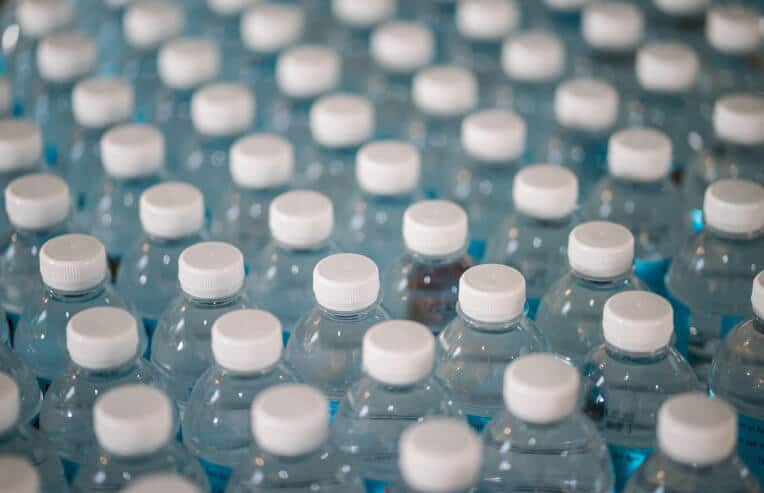Many of us don’t think twice about the makeup we wear or the container we use to pack our lunch. We know organic products are supposed to be better, but are they really that different from conventional products?

There are toxins – called xenoestrogens – lurking in the products you use every day. Even if you’re committed to using and eating only organic products, xenoestrogens are stealthy and can be hidden in unsuspecting places. And evidence of their harmful effects on human health continues to mount.
In this article, we’ll discuss what xenoestrogens are, how they may be affecting you and your family, and what you can do to fight back.
What are Xenoestrogens?
Xenoestrogens are foreign substances that are functionally or structurally similar to estrogen, namely 17β-estradiol (E2). Because of their similarities to estradiol, xenoestrogens can bind to estrogen receptors. This means xenoestrogens can exert estrogen-like activity in your body.
Xenoestrogens can be either synthetic or natural in origin. For example, phytoestrogens are a class of natural xenoestrogens and can be found in many foods. There are also natural mycoestrogens, which are produced by fungi.
Synthetic xenoestrogens are where we run into the most trouble. These synthetic compounds are known as endocrine-disrupting chemicals, or EDCs. Once absorbed, EDCs accumulate in your fat tissue, where they can stay for a long time. Even tiny, yet chronic exposures to EDCs can wreak havoc on multiple levels of your endocrine system by changing the levels of your natural hormones.
Unfortunately, their effects may not be evident until later in your life. And their effects can be transmitted from a pregnant woman to the developing fetus or child through the placenta and breast milk.1 This means their exposure can have a transgenerational effect.
How Do Xenoestrogens Affect Your Hormones?
In 2012, the World Health Organization published a document titled “State of the Science of Endocrine Disrupting Chemicals 2012.” The report stated that human and wildlife populations all over the world are exposed to increasing levels of EDCs, including those that are persistent organic pollutants. The incidence of many endocrine-related disorders and cancers are also rising, though the full extent of health risks from EDCs are still unknown.2
Here’s what we know regarding xenoestrogens’ effects on women.
Estrogen Dominance
Your hormones need to work together to achieve balance. For example, high estrogen levels can cause unchecked cellular growth and proliferation, leading to increased risk for genetic mistakes. Progesterone, on the other hand, can counteract some of estrogen’s activities, including inhibiting proliferation.
Unfortunately, achieving a balance between progesterone and estrogens can be difficult because of our exposure to xenoestrogens. A pattern of low progesterone and high estrogen levels is called “estrogen dominance.”
Some signs and symptoms of estrogen dominance include:
- Fatigue
- Weight gain
- Heavy menstrual bleeding and cramping
- Uterine fibroids
- Slow metabolism
- Irregular menstrual periods
- Difficulty sleeping
- Mood disorders (e.g., depression, anxiety)
- Vaginal dryness
Since everyone is exposed to xenoestrogens, women aren’t the only ones who can experience estrogen dominance. Men and children can also be affected. That’s right — men can become estrogen dominant, too! This can happen when testosterone and progesterone levels start declining as men age, which means they’re no longer at sufficient levels to counteract estrogens. Men can have some of the same symptoms women do, like weight gain, fatigue, mood swings, and low libido.
Learn more about estrogen dominance in my article here.
Cancer Risk
Certain types of cancers – namely breast, endometrial, ovarian, thyroid, and osteosarcoma – are driven by hormones. This again indicates that hormone balance is critical. Your hormone levels, whether they’re too high or too low, can play a significant role in your cancer risk.
Xenoestrogens have long been suspected to increase cancer risk.
For example, BPA is a synthetic compound widely used in plastics like food storage containers and baby bottles. The effects of BPA on the reproductive system of rats were first reported in the 1930s.3 Further animal studies found that BPA could induce oxidative stress, DNA damage, and epigenetic changes in oocytes.4
Even in very low doses, BPA can induce estrogen-like activities in cells – and these effects are similar to or stronger than those of estrogen.5 And because BPA can bind multiple types of estrogen receptors and estrogen receptor-related receptor gamma (ERR-γ), it’s protected from deactivation by estrogen receptor modulators.6 This may mean that BPA can continue to disrupt cell signaling pathways and evade your cells’ natural negative feedback mechanisms.
So how does BPA contribute to increased cancer risk?
Although researchers are still trying to understand the exact pathophysiology of many hormone-driven cancers, accumulating evidence suggests steroidal sex hormones (like estrogens) are involved in their development.
Let’s look at ovarian cancer, the 7th most common cancer among women.7 Studies have shown that about 50% of human ovarian epithelial cancer cells express higher estrogen receptor levels than do normal or benign ovarian lesion cells.8 Some researchers believe high levels of estrogen can create a favorable hormonal environment for tumor growth.9 This is one of the reasons why estrogen hormone replacement therapy should be used with caution in postmenopausal women. And since BPA mimics estrogen activities, some experts believe it could contribute to the development of ovarian cancer, though more epidemiological data are needed to confirm.10
Research studies have also confirmed that early life and long-term exposures to xenoestrogens from personal care products may contribute to breast cancer risk.11 But breast and ovarian cancer aren’t the only cancer types driven by xenoestrogens. Scientists have also linked lung, kidney, pancreas, and brain cancers to xenoestrogen exposure.12
Fertility Problems
If you have a condition related to high estrogen levels like polycystic ovarian syndrome (PCOS) or endometriosis, you may also have difficulty becoming pregnant. Some women may successfully become pregnant but have trouble carrying the baby to full term.
Xenoestrogen exposure is certainly not the only culprit when it comes to fertility problems. But they can exacerbate the problem – and harm the fetus.
In a 2005 study, female mice were exposed to low, environmentally relevant doses of BPA during pregnancy. The results showed that exposure of the developing fetus to the toxin caused changes in DNA synthesis.13
A review published in 2020 found that BPA could be involved in the development of female infertility. BPA is often detected in infertile women, leading some scientists to think that it could interfere with natural conception. BPA exposure has also been correlated with negative outcomes of fertility treatments. BPA can also impair the secretion of sex hormones, which can affect ovarian function. This effect may be behind the induction of PCOS-like abnormalities after BPA exposure.14
To sum it up, there are strong correlations between xenoestrogen exposure and fertility issues. But we will need more studies to confirm the link and to make women more aware about the health risks related to xenoestrogen exposure.
Common Sources of Xenoestrogens

Unfortunately, xenoestrogens lurk in items you use and in foods you consume every day. Some of the most common sources of xenoestrogens include (but are by no means limited to):
- Agricultural spraying, such as pesticides and herbicides
- Waste disposal pollutants, like polychlorinated biphenyls (PCBs) and dioxins
- Plastics, which can be made of bisphenol A (BPA) and phthalate esters
- Food preservatives like methylparaben, ethylparaben, propylparaben, and butylparaben
- Pharmaceuticals, including birth control pills
- Personal care products and cosmetics
- Perfumes, colognes, air fresheners, and artificial fragrance
- Other environmental pollutants like cigarette smoke and automobile exhaust
It’s important to note here that the effects of xenoestrogens aren’t just limited to you. Just as secondhand smoke affects nonsmokers, other people and organisms in the environment are affected by the products you choose.
How You Can Fight Back Against Xenoestrogens
When you look at the list above, it can be overwhelming – how do you eliminate xenoestrogens when they’re simply everywhere?
The unfortunate truth is it may not be possible to get rid of xenoestrogens from your life completely. But there are things you can do to actively avoid or reduce your exposure to them.
Here are my top tips on how to fight back against xenoestrogens.
1. Clean Up Your Personal Care and Household Products
Personal care products, like sunscreen, cosmetics, and household cleaning products can all contain xenoestrogens. Skincare products, in particular, are potentially harmful because they’re the most readily absorbed. And since these products aren’t consumed orally, the xenoestrogens in them are able to bypass your liver’s detoxification efforts.
What you put on your skin is incredibly important.
But with the large number of ingredients these products have, it’s incredibly difficult to sort out which ones are safe. In general, watch out for the following ingredients:
- Phthalates, including those that hide under the term “fragrance”
- Parabens
- Triclosan (avoid products marketed as “antibacterial” or “odor-fighting”)
- Sodium lauryl sulfate
- Bleach (in feminine hygiene products)
- Chlorine and chlorine by-products
You can avoid these ingredients more easily by choosing organic and biodegradable skincare products.
2. Choose Organic Foods
By choosing organic food whenever possible, you’re reducing your overall exposure to pesticides, herbicides, and other chemicals that are added to food. If you eat meat or dairy, look for products from grass-fed, pasture-fed, or hormone- and antibiotic-free animals. Since BPA and other xenoestrogens can be found in plastics, try to avoid food in plastic containers or cans.
Organic certainly doesn’t mean pesticide- or herbicide-free, but it does mean you’ll be able to avoid most toxic chemicals like glyphosate, which has been implicated in human health concerns.
Check out the National List of Allowed and Prohibited Substances for organic production here.
3. Be Wise About Feminine Hygiene Products
You know it’s important to read food and household product labels, but there’s another source of EDCs that many women overlook: feminine hygiene products.
Feminine hygiene products are especially concerning because the mucous membranes of the vaginal area are highly permeable. This means EDCs can enter your bloodstream much more easily.
Some of the problematic chemicals found in feminine hygiene products include:15,16
- Bleach
- Dioxins and furans
- Phthalates (often under the term “fragrance”)
- Toluene
- Xylene
- Methyl chloride
- Pesticide residues
- Bisphenols
- Parabens
To avoid these toxins, opt for the following:
- Organic tampons
- Organic disposable pads
- Organic reusable cloth pads
- Menstrual cup
The products listed above are much better for your vaginal health. And despite an initial investment, menstrual cups will help you save money in the long run.
4. Eat a Fiber-Rich Diet
High-fiber diets have been associated with decreased breast cancer risk, likely because fiber can help lower estrogen levels.17 Additionally, a fiber-rich diet can help reduce your risk of cardiovascular disease, stroke, diabetes, and colon cancer.18
5. Avoid Soy Products
Phytoestrogens are found in a variety of foods, of which soy is probably the most well-known. Many people are wary of soy-based products for this very reason.
So what’s the verdict on soy?
Research studies involving thousands of women suggest soy may actually help protect against certain cancers, like breast cancer. For example, a meta-analysis of 35 studies reported that soy consumption may help reduce breast cancer risk for both pre- and post-menopausal women in Asian countries.19
One recent review of 23 studies found that soy had a positive influence on women with fertility issues, which may indicate that it could improve outcomes for those using assisted reproduction techniques. The authors of the study couldn’t find any negative effects of soy consumption in healthy women.20
Another meta-analysis of 81 studies showed that higher intake of soy was associated with a 10% reduction in cancer incidence.21
Despite these modest benefits, there is one key reason to avoid soy in your diet. Soybeans are the stars of genetically modified foods, which pose abundant health risks. They also contain compounds that act as antinutrients, lowering your body’s ability to absorb certain vitamins and minerals. Some animal studies suggest these antinutrients could damage gut barrier function, though human studies are needed to confirm.22
In short, the health benefits you may gain by eating soy can easily be achieved by eating plant foods like greens and other vegetables. And these plant foods aren’t xenoestrogens, genetically modified, or antinutrients. So in my professional opinion, consuming soy is just not worth the risk.
6. Support Estrogen Detoxification
Your liver is your main detoxification organ, which means liver health can be crucial when it comes to ridding your body of xenoestrogens.
Here are some ways you can support liver health:
- Exercise: According to research studies, exercise can promote healthy estrogen and progesterone levels.23,24
- Herbs: Some herbs like milk thistle, dandelion, and burdock root are great for supporting your liver, which is your body’s primary organ of detoxification. But they should always be used under the guidance of a physician.
- Saunas: Saunas stimulate the release of toxins through sweat. One review found toxic metals like arsenic, cadmium, lead, and mercury can be excreted through sweating.25
- Antioxidants: Antioxidants scavenge free radicals, which can cause cellular damage through oxidative stress. Consuming antioxidant-rich foods like curcumin can help maintain a healthy liver.26
- Green tea: Some people are wary of green tea due to concerns about liver toxicity. But a recent analysis reported that green tea actually reduced the odds of having one or more abnormal liver biomarkers (e.g., bilirubin). There were no associations between green tea supplements and liver toxicity.27
Empower Yourself Against Xenoestrogens
It can be overwhelming to know that you’re surrounded by xenoestrogens. You may feel like you’re doing everything right, but that there’s no escaping these toxic chemicals.
Positive lifestyle changes happen one step at a time. So start by replacing just one product in your cabinet. Then, the next time you run out of an unhealthy product, replace it with a healthier, organic one.
If you’re concerned you may be experiencing the damaging effects of xenoestrogens, I’m here to help. As an expert in natural medicine for women’s health, I know small changes can lead to big results over time.
Schedule a free 15-minute consultation today to learn more about how I can help you.
References:
- https://rbej.biomedcentral.com/articles/10.1186/s12958-019-0558-8
- https://www.unep.org/resources/report/state-science-endocrine-disrupting-chemicals
- https://www.nature.com/articles/137996a0
- https://pubmed.ncbi.nlm.nih.gov/29102535/
- https://www.ncbi.nlm.nih.gov/pmc/articles/PMC4602822/
- https://pubmed.ncbi.nlm.nih.gov/17761695/
- https://pubmed.ncbi.nlm.nih.gov/31118829/
- https://pubmed.ncbi.nlm.nih.gov/31118829/
- https://pubmed.ncbi.nlm.nih.gov/16169144/
- https://www.ncbi.nlm.nih.gov/pmc/articles/PMC4602822/
- https://www.ncbi.nlm.nih.gov/pmc/articles/PMC4602822/
- https://ehjournal.biomedcentral.com/articles/10.1186/1476-069X-11-S1-S8
- https://academic.oup.com/biolreprod/article/72/6/1344/2667099?login=true
- https://rbej.biomedcentral.com/articles/10.1186/s12958-019-0558-8
- https://pubmed.ncbi.nlm.nih.gov/31945693/
- https://repository.usfca.edu/cgi/viewcontent.cgi?article=2741&context=capstone
- https://www.ncbi.nlm.nih.gov/pmc/articles/PMC2744625/
- https://www.ncbi.nlm.nih.gov/pmc/articles/PMC2744625/
- https://journals.plos.org/plosone/article?id=10.1371/journal.pone.0089288
- https://www.cambridge.org/core/journals/journal-of-nutritional-science/article/role-of-soy-and-soy-isoflavones-on-womens-fertility-and-related-outcomes-an-update/29483840F197DC57A2BD0DCEE2A3543F
- https://www.frontiersin.org/articles/10.3389/fnut.2022.847421/full
- https://www.ncbi.nlm.nih.gov/pmc/articles/PMC3257084/
- https://www.ncbi.nlm.nih.gov/pmc/articles/PMC6090977/
- https://pubmed.ncbi.nlm.nih.gov/21903887/
- https://www.ncbi.nlm.nih.gov/pmc/articles/PMC3312275/
- https://www.ncbi.nlm.nih.gov/pmc/articles/PMC4526841/
- https://www.sciencedirect.com/science/article/pii/S0273230021002282




